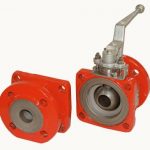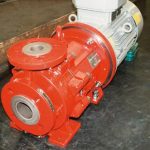For many plant operators, PFA-P facilitates a significant extension of service life when used as a lining in valves and pumps. This is attributable to the excellent resistance of the material to highly permeating media. The chemical and physical properties relevant to applications permit the use of PFA-P wherever pure PFA has proved successful.
Manfred Kluge
Linings made of the well-known thermo-fluoroplastic PFA (perfluo-roalkoxy) are used as an alternative to expensive, high-alloy metals for pumps, valves, control valves, containers, etc. PFA has superseded PTFE, which is processed using a pressure sintering technique, in these applications to a large extent. PFA’s success is attributable to several important advantages over PTFE. It is transfer-moulded, which means that the lining wall thicknesses can be accurately defined and reproduced. It is almost transparent and therefore permits much more reliable quality control. Moreover, thanks to its dense molecular structure, PFA has generally far lower permeation rates than PTFE with equivalent wall thicknesses, yet boasts the same chemical and thermal resistance properties.
Barrier effect of PFA
In the case of media with a high tendency to permeate, such as chlorine, bromine or fluorine compounds, even the good barrier effect of pure PFA with the normal wall thickness of ±3 mm is often not sufficient to achieve a satisfactory service life of the equipment. If the chemical penetrates the lining, this may cause corrosion on the pressure-bearing metal body and possibly cause the complete unit to fail. Experience shows that increasing the PFA lining wall thickness to no more than 5 or 6 mm results in a substantially longer service life. This is common, for example, in ball and globe control valve bodies. A quadratic relationship exists between the breakthrough time, i.e. the time the medium takes to permeate through the plastic and emerge again, and the wall thickness. In most applications, the breakthrough time is higher than the useful life of the unit because the temperature and pressure gradients driving the permeation process decrease significantly towards the outside. This can also be observed in pump housings, which usually feature thick-walled PFA linings of 5 to 6 mm as standard. When it comes to internally wetted components, however, such as shut-off elements, stems, pump shafts, inner magnetic assembly linings and cans, the wall thickness cannot be increased, or only to a very limited extent, for functional reasons. This is precisely where permeation can cause early failure of the unit.
Higher permeation resistance
The aim was therefore to provide a lining material that is even more resistant to permeation. The material engineers concentrated their efforts on creating a PFA variant which is suitable for melt processing, but with much higher permeation resis-tance and with the same chemical and temperature resistance from –60 to 200 °C. A material is now available which satisfies these general conditions in the shape of the compound PFA-P (P stands for permeation). The carrier polymer PFA is enriched with an extremely corrosion-resis-tant filler. This filler extends the diffusion paths and acts as a diffusion barrier. The surface resistance of PFA-P to electrical conductivity corresponds to that of PFA. As a lining material, it covers the same pres-sure and temperature ranges as pure PFA for valves, globe control valves, pumps, etc., i.e. from –60 to 200 °C and from vacuum up to 25 bar. Both the PFA base material and all fillers and auxiliary agents used in the production process are FDA-compliant.
In order to confirm the permeation resistance, the permeation of chlorine gas was examined under operating conditions as an example. In this test, samples of different thicknesses made of PFA-P and pure PFA were compared with one another at temperatures of up to 150 °C and pressure differences of up to 7 bar. The result: the permeation through PFA-P is roughly half of that for pure PFA. This effect is particularly noticeable at critical, high operating temperatures. Tests with extremely mobile helium as a test medium also showed a similar reduction in permeation. Although the permeation rates of solvents tend to be considerably lower, experience shows that they follow the same trend, so that PFA-P is likely to produce substantial improvements here too.
Practical examples
A KN/F-P ball valve (DN 25) lined with PFA-P was tested in an application in which monochloroacetic acid was present at approximately 150 °C, as an alternative to special valves made of special materials. Even after eighteen months in continuous use, this ball valve showed no signs of failure. What’s more, it is considerably cheaper than the special valve previously used. The PFA-P-lined ball valve in the KN series covers a broad operating spectrum with a temperature range from –60 to 200 °C and a pressure range from 1 mbar to 16 bar. The KN modular system comprises nominal widths from DN 15 to 200 and ½“ to 8“, with face-to-face dimensions and flanges to ISO 5752–1/7005–2 and ANSI B 16.10/B 16.5 Cl. 150. PFA, FEP, antistatic PFA-L and PFA-P are available as lining materials. ITT Richter decides on the basis of each specific problem whether a PFA-P lining is neces-sary for the entire unit or only for critical components. In many cases it is sufficient simply to line individual components with PFA-P instead of PFA or PTFE, while the main part of the valve continues to be lined with standard PFA. The valve is type-tested, complies with the German Clean Air Code and is also approved to GGVSE/ADR/RID/TRT24 for the transport of ha-zardous goods in tanks. Depending on the application, the KN can be equipped with a PFA or Al2O3 shut-off ball or TF ball. With the V control ball and a special hysteresis-free coupling between the ball valve stem and the actuator, the KN becomes a complete control valve for cv 0.8 to 400.
Also suitable for pumps
The PFA-P linings can also help significantly extend the service life of pumps. In one specific case, the normal service life of a PFA-lined magnetic drive pump for conveying trifluoroacetic acid (50 °C) was roughly three months. The pump failed because the internals were heavily swollen by permeation. The metallic base material was corroded and the rotating unit stuck. The PFA-P-lined MNK pump now in use has been running for twelve months without any indication of modifications to the material. The MNK series handles flow rates from 1 to 375 m³/h and delivery heads of up to 145 m. The pumps are available in foot-mounted and close-coupled designs for temperatures from –60 to 200 °C and operating pressures of up to 16 bar or up to 25 bar with accessories. PFA/PTFE, antistatic PFA/PTFE, the new PFA-P and PP/PE-UHMW can be used as lining material. The wetted surfaces are completely metal-free.
Thanks to the non-metallic, eddy current-free separating can, the MNK is also suitable for media close to boiling temperature. A PFA-lined magnetic drive pump used in an FHC-H2SO4-HF mixture at 180 °C, for example, always failed after a maximum of twelve months owing to core corrosion on all wetted components. The MNK 50–32–160 now in service, which is completely PFA-P-lined, is still operating after two years without any repairs. In an- other application involving an H2SO4-HF mixture (125 °C), the fluid diffused through the standard inner can made of modified TFM-PTFE and dissolved resin out of the outer, pressure-bearing CFRP separating can of the MNK magnetic drive pump. This effect was audible after a few months in service, when the resin particles which had hardened in the drive section of the pump were swirled around. The can was replaced with one made of PFA-P. Tests after a further six and twelve months showed that this problem had been rectified as a result. In addition to the ball valves and pumps described here, control valves, sight glasses, sampling valves, vessel drain valves and safety valves can also be manufactured with a PFA-P lining.
cpp ###
More information about the pumps and valves
Seminar program
Data base for polymer technology
Technopharm 2005
Share:









